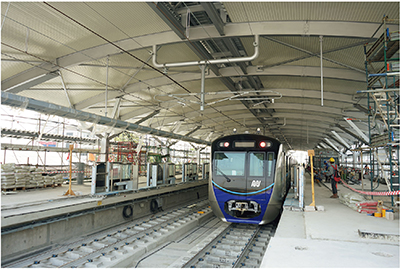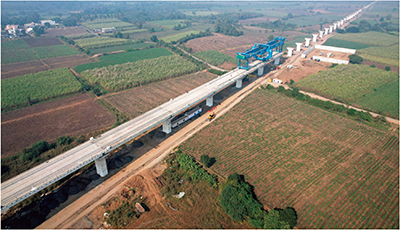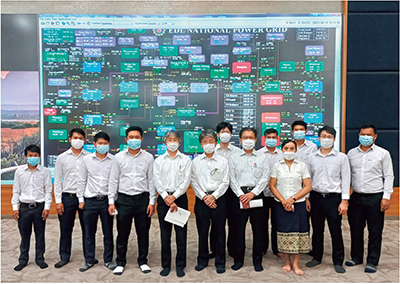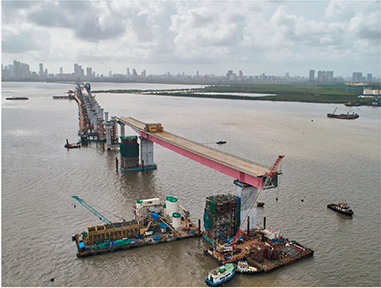(3) Quality Infrastructure

Station building under construction and a train through a loan aid project for Indonesia, “Construction of Jakarta Mass Rapid Transit Project (Phase 2) (I).” (Photo: JICA)
For the autonomous development of developing countries, infrastructure that supports people’s lives and economic activities and serves as the foundation for their national development is essential. However, developing countries still have enormous demand for infrastructure and the investment gap between infrastructure demand and supply is estimated to be approximately 15 trillion US dollarsNote 27 by 2040. In order to achieve “quality growth”Note 28 in developing countries, it is necessary to meet this enormous demand for infrastructure. It is very important not only to develop a large amount of infrastructure but also to consider openness, transparency, economic efficiency in view of life-cycle costs, and debt sustainability, etc.
Japan has strengths related to maritime and aviation safety management, disaster risk reduction and resilience technologies, urban development that contributes to addressing climate change and environmental issues, safe transportation systems, electricity and energy infrastructure, and water supply. In order to leverage these strengths to solve social issues in partner countries, Japan promotes the development of “quality infrastructure”Glossary by combining structural and non-structural support. For structural support, it provides infrastructure development in line with the economic and development strategies of each developing country, while for non-structural support, it provides cooperation for institutional development, management and maintenance, and human resources development.
● Japan’s Efforts

Full span casting (a method for construction of viaducts) as part of the “Project for the Construction of Mumbai-Ahmedabad High Speed Rail” in India (Photo: National High Speed Rail Corporation Limited (NHSRCL))

Members of the National Control Center and a team of Japanese experts in the “Project for Power Quality Improvement through Upgrading Grid Code and Strengthening its Enforcement System” in Laos (Photo: JICA)
Japan has been working with the international community to disseminate the notion of “quality infrastructure,” with the aim of international standardization of it so that more people will have access. The “G7 Ise-Shima Principles for Promoting Quality Infrastructure Investment,” endorsed at the G7 Ise-Shima Summit under the Japanese Presidency in May 2016, was the initial step of sharing the fundamental elements of “quality infrastructure investment.” In addition, at the G20 Osaka Summit under the Japanese Presidency in June 2019, the “G20 Principles for Quality Infrastructure Investment,”Note 29 which indicate a strategic direction for promoting quality infrastructure investment, were endorsed. Japan cooperates with various countries and international organizations to promote and implement the Principles, and the importance of “quality infrastructure investment” has been confirmed at various bilateral and multilateral meetings.
At the G7 Elmau Summit in June 2022, the Partnership for Global Infrastructure and Investment (PGII),Note 30 an initiative for the G7 to work together to promote quality infrastructure investment to narrow the global investment gap, was launched. Under the PGII, the G7 leaders announced their aim to collectively mobilize up to 600 billion US dollars in public and private investment over five years, with a particular focus on quality infrastructure. Prime Minister Kishida stated that in order to promote infrastructure investment in line with the G20 Principles for Quality Infrastructure Investment, Japan aims to mobilize more than 65 billion US dollars in infrastructure assistance and private capital, and will continue to deepen cooperation with the G7 and other countries.
At the G7 Hiroshima Summit in May 2023, Prime Minister Kishida hosted a side-event on the PGII and invited participants from the private sector for the first time. During the side-event, Prime Minister Kishida explained the initiatives of the PGII and the projects that Japan has undertaken under the PGII. He also stated that Japan is delivering infrastructure investment around the world including Asia, Africa, and Oceania to mobilize infrastructure assistance and private capital and that Japan would work to further promote quality infrastructure investment (see Part I, Section 2 for details of the G7 Hiroshima Summit).
The Ministerial Statement issued at the OECD Ministerial Council Meeting in June 2023 confirmed the member countries’ commitment to promoting quality, reliable, sustainable, and resilient infrastructure investment including through the G20 Principles for Quality Infrastructure Investment and PGII, and acknowledged the importance of promoting certification schemes such as the Blue Dot Network (BDN).Note 31
Prime Minister Kishida attended a side-event on the PGII on the sidelines of the G20 New Delhi Summit in September 2023, and expressed Japan’s commitment to take the lead in efforts to materialize the PGII, in cooperation with various actors.
At the side-event, Prime Minister Kishida introduced that Japan has been working on the development of various transport infrastructures, such as the construction of metro lines in New Delhi, India, to support the economic growth of each country as one of Japan’s major initiatives in South Asia. He also stated that Japan would take the achievements to date a step further by extending its support to a wide range of areas, including the supply chain, to strengthen connectivity. He also announced Japan’s intention to work on the creation of industrial value chains across the Bay of Bengal by organically linking the development of the northeast region of India, including the “Road Network Connectivity Improvement Project,” with “the Bay of Bengal Industrial Growth Belt (BIG-B)” initiative in Bangladesh.
In ASEAN, Japan has promoted many projects to develop transport infrastructure such as the Sihanoukville Port in Cambodia, the Patimban Port and Jakarta Mass Rapid Transit in Indonesia, and the Metro Manila Subway in the Philippines. At a side-event of the ASEAN-related Summit Meetings in September 2023, Prime Minister Kishida announced the “Japan-ASEAN Comprehensive Connectivity Initiative,” which promotes both structural and non-structural cooperation. He announced that Japan would support the strengthening of connectivity in areas including digital connectivity, maritime cooperation, supply chain resilience, electricity connectivity, and human and knowledge connectivity, in addition to the transport infrastructure development that Japan has been supporting.
For efforts in Pacific Island countries, Japan, the United States, Australia, Kiribati, Nauru, and the Federated States of Micronesia jointly announced Japan-U.S.-Australia joint support for the East Micronesia Cable (EMC) in December 2021, and in June 2023, an undersea cable contract was signed, leading to the steady progress of the project. In these ways, Japan will continue to support the development of quality infrastructure in the ICT field to strengthen connectivity in the Indo-Pacific region in order to realize a “Free and Open Indo-Pacific (FOIP)” in cooperation with the United States, Australia, and other like-minded countries.
For the African region, at the Eighth Tokyo International Conference on African Development (TICAD 8) held in Tunisia in August 2022, Japan announced initiatives that would promote enhancement in regional connectivity, in addition to improving social infrastructure development in Africa through the development of quality infrastructure and one-stop border posts at national borders.
The Government of Japan will continue to disseminate the “G20 Principles for Quality Infrastructure Investment” throughout the international community, and will further work on efforts to implement “quality infrastructure investment” together with countries around the world including Asian countries and international organizations such as the World Bank, the Asian Development Bank (ADB), and the OECD.
Featured Project 1
India
Utilizing Japanese Technology to Develop Infrastructure that Improves Connectivity within the Mumbai Metropolitan Region
Mumbai Trans-Harbour Link Project
Loan Aid (March 2017 – March 2024)
While India has seen rapid urbanization in recent years, the development of public transportation infrastructure has not progressed sufficiently. This leads to increasingly serious traffic congestion in major metropolitan areas, and the economic losses associated with it have become an obstacle to economic development. The Mumbai metropolitan region, the largest metropolitan region in the country situated in the west coast of India, hosts many Japanese companies, and the city of Mumbai at the center of the metropolitan region is one of the most densely populated cities in the world. The Government of Maharashtra, which has jurisdiction over Mumbai City, has been promoting urban development by attracting industries from Mumbai City to its satellite city of Navi Mumbai on the opposite coast, in order to develop the economy of the entire metropolitan region. However, the only means of transport connecting the two areas is by road or by rail that circle Mumbai Bay, and the lack of connectivity has been an issue.
This project aims to improve connectivity within the Mumbai metropolitan region by constructing a sea-crossing road bridge with a total length of approximately 18 km and a land approach road with a total length of approximately 4 km. The road will connect central Mumbai to the developing Navi Mumbai area across Mumbai Bay. A Japanese technology called orthotropic steel deck (OSD)Note 1 is used for the first time in India. With the technology, bridge girders can be erected at once leading to shorter construction times and environmentally friendly construction.
This project is expected to shorten travel time between central Mumbai and the city of Navi Mumbai from one hour to approximately 15 minutes, a quarter of the time it used to take. Improving connectivity in the Mumbai metropolitan region, which hosts many Japanese companies, is expected to not only promote economic development in the region, but also benefit Japanese companies operating in other parts of the state of Maharashtra.

Orthotropic steel deck (OSD) erection work at sea (Photo: MMRDA/L&T-IHI Consortium)
Note 1: A type of steel bridge that combines steel deck slabs and steel box girders. Because it is lightweight and has an all-steel structure, there is little variation in construction accuracy, allowing for highly accurate construction. In addition, compared to typical PC cable-stayed bridges, the OSD bridge is characterized by a lower height. This technology was considered appropriate for this project in consideration of the birds that inhabit the project area.
Glossary
- Quality infrastructure
- Infrastructure that genuinely contributes to “quality growth” that is “resilient” against natural disasters and other risks, “inclusive” so that no one is left behind, and “sustainable” taking into account its impact on society and the environment. The “G20 Principles for Quality Infrastructure Investment,” which incorporate key elements for investing in “quality infrastructure” such as (i) openness, (ii) transparency, (iii) economic efficiency in view of life-cycle costs, and (iv) debt sustainability, were endorsed at the G20 Osaka Summit in June 2019.
- Note 27: Forecasts by the G20 Global Infrastructure Hub (GIH).
- Note 28: See the glossary.
- Note 29: See the glossary “Quality Infrastructure.”
- Note 30: PGII is the G7’s shared commitment to promoting public and private investment in sustainable, inclusive, resilient and quality infrastructure.
- Note 31: A framework for internationally accrediting quality infrastructure projects in developing countries to be established by Japan, the United States, and Australia, with the United States taking the lead since November 2019.
